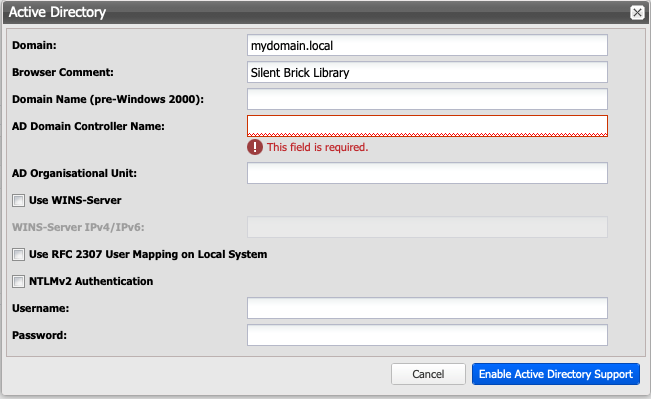Adjust SMB settings.
Adjust SMB settings.
In the "SMB" section, you can configure the global Samba settings. These include managing local Samba users as well as integration with Active Directory.
Local SMB users
Create user
➤ In the "SMB" area under "Users", click the "Add" button.
➤ Complete all required information in the subsequent window.
➤ Save the new user by clicking the "Save" button.
Edit User
➤ Select the corresponding user under "Users" in the "SMB" section.
➤ Open the edit dialog by double-clicking the user.
Delete User
➤ Select the corresponding user under "Users" in the "SMB" section.
➤ Delete the user by clicking the "Remove" button.
Integration with Active Directory
To use users and groups from Active Directory, connect the Silent Brick System to Active Directory as follows:
➤ Click the "Edit" button under "Active Directory" in the "SMB" section.
➤ Complete the edit dialog as follows:

Value | Description |
|---|---|
Domain | Enter the full domain name (e.g., 'fast-lta.intern'). |
Browser Comment | This is an optional value and is displayed as a comment in Explorer if desired. |
Domain Name (pre-Windows 2000) | The short name of the domain (e.g., 'fast-lta'). |
AD Domain Controller Name | The full DNS name of the primary domain controller (e.g., 'dc01.fast-lta.intern'). |
AD Organizational Unit | Target OU for adding the computer account. |
Use WINS Server | If a WINS server is in use, it can be specified here. |
Use RFC 2307 User Mapping on Local System | Using RFC 2307 user mapping in Samba enables centralized management of Unix user and group IDs within Active Directory, ensuring that all Samba servers utilize consistent user identifiers and reducing administrative effort. |
NTLMv2 Authentication | Particularly in newer Windows Server versions and in secured environments, it may be necessary to enable NTLMv2 Authentication. |
Username | Enter the username of a domain administrator. This is required to join the machine to the domain. User credentials are not stored! |
Password | Enter the corresponding password. User credentials are not stored! |
➤ Click the button "Enable Active Directory Support."
Leaving Active Directory
To remove the Active Directory configuration, proceed as follows:
➤ Click the "Edit" button under "Active Directory" in the "SMB" section.
➤ In the following dialog, enter the username and password of a domain administrator.
➤ Click the button "Disable Active Directory Support."
